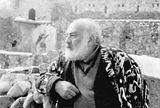Kuz'ma Petrov-Vodkin (1878-1939) painted, among other things, Christian (loaves and fishes) and homoerotic images like this one, "Boys Playing," 1911 (see also his painting "Bathing the Red Horse").
Serge Diaghilev (1872-1929) is best known in the West
as a ballet impresario, for organizing Russian ballets and bringing them
to the attention of the world. In Russia he is also known as the mastermind
behind the World of Art -- a group of artists, a series of regular exhibits,
and a journal. Karlinsky points out that Diaghilev organized and promoted
the World of Art group during his liaison with the painter Dmitry Filosofov.
Filosofov eventually left Diaghilev, and the latter's meeting with the dancer
Vaslav Nijinsky (1889-1950) sealed both men's fates. In their five year
affair, as Karlinsky writes, Diaghilev placed Nijinsky at the center of
such masterpieces as Stravinsky's Petrushka and Rite of Spring, Debussy's
Afternoon of a Faun, and Ravel's Daphnis and Cloe. See Karlinsky's "Sergei
Diaghilev: Public and Private," The Christopher Street Reader
(NY: Perigee, 1983), 265-273.
Vaslav Nijinsky (1889-1950) was successful as a dancer and choregrapher while he was Diaghilev's lover. He later married and went mad. Nijinsky at gay.ru.
Konstantin Somov (1869-1939), whose self-portrait you see here, was one of the gay members of the World of Art group. In high school he had a passionate affair with Dmitry Filosofov, who later became Diaghilev's lover.
No one seems to doubt that Petr Ilich Tchaikovsky (1840-93)
was gay, yet many have put a homophobic spin on his homosexuality. See,
for example, the Encyclopaedia Britannica article, which states " His
abnormal love for his now-deceased mother and the ineffectualness of his
father did nothing to hinder his latent homosexuality, and the disciplinary
regime of the all-male School of Jurisprudence cannot have helped. There
is, however, no evidence of his having given any active outlet to his secret
desires." In fact, there's a lot of evidence! See also his Classics World Biography.
Both repeat the persistent rumors to the effect that Tchaikovsky's death
was a suicide forced by classmates who were appalled at his homosexuality.
Karlinsky and Poznansky have shown these to be homophobic drivel based on
hearsay and pure speculation. For the true story see Poznansky's book, Tchaikovsky:
The Quest for the Inner Man (1991) Karlinsky, "Tchaikovsky and
the Unholy Alliance," Harvard Gay and Lesbian Review, Vol.
iii., No. 4 (Fall, 1996), 31-33 and Richard Taruskin in The New Republic,
Feb. 6, 1995. Tchaikovsky
at gay.ru.
Anatoly Mariengof (L) and Sergei Esenin (R)
Aren't they cute? According to biographers, Sergei Esenin (1895-1925) and Anatoly Mariengof (1897-1962) had a "legendary passionate friendship" that lasted 3 years. Karlinsky argues that Esenin's best love poetry is that addressed to men.
Viktiuk's production of Genet's The Maids
Roman Viktiuk is arguably the most popular Russian stage director alive today. In the late 1980s he began directing a series of plays with homoerotic content. Even plays that were not explicitly written as gay invariably included shirtless men! Among the most famous productions: Genet's The Maids, which was put on with men in drag; M. Butterfly; and Kolyada's Slingshot (which he first staged in the US -- the English translation is included in our anthology).
See Vitaly Lazarenko's Viktiuk at gay.ru.
Artwork by Oleg and Viktor (click for a larger image)
Timur Novikov runs an art gallery in Petersburg, the New Academy at 10 Pushkinskaia St., and arranges various happenings and raves. He also handles the work of Oleg and Viktor -- Oleg Maslov and Viktor Kuznetsov, who work as a team. They produce kitschy photos a la von Gloeden and Hockney-like realist paintings. In the photos Oleg and Viktor themselves appear as models.
Mogutin (R) and Philippini (L) at their wedding
Slava Mogutin was the self-styled "American Culturologist," the enfant terrible of Russian journalism. He was one of the first to publish on gay topics in Russia. Mogutin also writes poetry and edited the 2 volume collection of the works of Yevgeny Kharitonov. On April 12, 1994 Mogutin made news by attempting to marry his American boyfriend, Robert Filippini, at the Moscow Palace of Weddings.
Check out Mogutin Online, including his latest book!
See the pages on
How about the uncontested master himself, Sergei Eisenstein? Karlinsky writes that when he was in Mexico filming Que Viva Mexico his homosexuality nearly caused an international scandal, and he was blackmailed into returning to the Soviet Union by the authorities, who threatened to expose his private life. For an analysis of homoerotic images in his films (remember the cannons in Potemkin?) see Thomas Waugh, "A Fag Spotter's Guide to Eisenstein," Body Politic, no. 35 (July/August 1977). Some of Eisenstein's erotic drawings were published in Literaturnoe obozrenie: Erotika v russkoi literature (1992). Here's his humorous drawing of a costume for Maliutin in Ivan the Terrible.

Sergei Paradjanov (1924-1990) was one of the most innovative and controversial filmmakers to work in the Soviet Union. His films, which include The Color of Pomegranates and The Legend of the Suram Fortress are stunningly beautiful and rich in color and imagery. Paradjanov spent most of the 70s in prison for "homosexuality and illegal trafficking in religious icons." Many of his films feature idealized male beauty, and he inspired Tarsem, the director who shot R.E.M.'s video of "Losing My Religion."